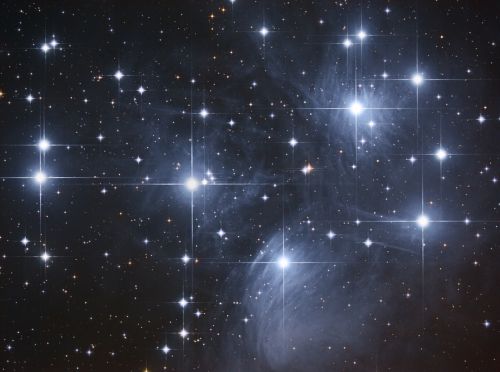SkyCaramba weekly astronomy blog for the week ending November 26, 2011
Many people spot a group of stars that looks like a kite flying high in the evening sky this time of year. Those are the Pleiades, part of the constellation Taurus. Another name for them is the Seven Sisters. Most people actually see six. A look with binoculars or a telescope reveals several dozen stars in the cluster.
One ancient Greek legend says the sisters, daughters of Atlas, were turned into stars after Atlas was given the job of holding up the entire world. An atlas is a collection of maps of the world, named after him.
The visibility of only six Pleiades when they are supposed to represent the Seven Sisters has inspired legends of the “Lost Pleiad.” The most commonly told is that Electra. She’s shocked to see her home city Troy burning and hides her face.
Another story says Merope wasn’t made as bright as the others because she married a mortal. The other sisters married immortals. Yet another story says she couldn’t fit in with the other sisters anymore and left for Hades. The sky is no place to find someone who’s in the underworld.
In another story, a thunderbolt hit Celaeno and she disappeared.
Interestingly, other cultures looked at the Pleiades and also told stories of a seven star system with one missing. The Iroquois in North America described seven boys who answered a call to join the stars in the sky. One of the boys is so homesick he covers his face while he cries.
The Aborigines of Australia say a crow fell in love with a queen and took her away from her six servants. She didn’t go willingly. He tricked her by turning himself into a grub when the queen and her servants were out looking for food at night. The servants couldn’t get him out of the tree bark he was hiding in. When the queen tried, the trickster turned into a rat and took the queen away.
 It’s intriguing that people separated by continents when there was no way of communicating across oceans told their own tales of a missing seventh star. Some modern astronomers think that means there actually were seven stars easily visible a long time ago. The Greeks, the Iroquois, and the Aborigines may have told stories appropriate for their own cultures to explain why one vanished. If that’s true, one of the many Pleiades you see in a magnified view could have been the one that faded from naked eye visibility. Perhaps someday science will find a way to say for sure.
It’s intriguing that people separated by continents when there was no way of communicating across oceans told their own tales of a missing seventh star. Some modern astronomers think that means there actually were seven stars easily visible a long time ago. The Greeks, the Iroquois, and the Aborigines may have told stories appropriate for their own cultures to explain why one vanished. If that’s true, one of the many Pleiades you see in a magnified view could have been the one that faded from naked eye visibility. Perhaps someday science will find a way to say for sure.
The Pleiades are up just about all night this time of year. Look in the east after sunset. They’ll be above a V-shaped group of stars but below the very bright Jupiter. If you look for them around midnight, you’ll see them close to the meridian (a line running north-south over you). And before sunrise, you’ll see them setting below the Hyades.
